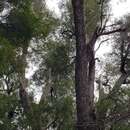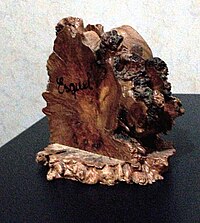fi
nimet breadcrumb-navigoinnissa


Die Coihue-Südbuche, Coihue oder Chilenische Scheinbuche (Nothofagus dombeyi) ist eine Pflanzenart aus der Gattung der Südbuchen (Nothofagus) in der Familie der Scheinbuchengewächse (Nothofagaceae). Da die deutschen Namen allerdings innerhalb der Gattung mehrfach vergeben wurden, ist die Mitverwendung des botanischen Namens anzuraten. In Chile werden die Trivialnamen Coihue, Coigüe oder Coygüe verwendet.
Nothofagus dombeyi wächst als immergrüner Baum, der Wuchshöhen von bis zu 40, als über das Kronendach ragender Emergent selten bis zu 50 Meter[1] und Stammdurchmesser von 2,5 bis über 3 Meter erreicht. Die rissige Borke ist grau. Die jungen Zweige sind relativ dünn und besitzen eine rotbraune Rinde.
Die wechselständig und zweizeilig bis spiralig am Zweig angeordneten Laubblätter besitzen einen 3–9 mm langen Blattstiel. Die einfache, etwas ledrige, steifliche, bis auf den Mittelnerv kahle, kleine und spitze bis stumpfe Blattspreite ist mit einer Länge von 2–4 cm und einer Breite von 1–2 cm eiförmig bis elliptisch und drüsig punktiert mit einer spitzen bis abgerundeten Spreitenbasis. Der Blattrand ist ungleich gesägt bis gekerbt. Es sind Nebenblätter vorhanden.
Nothofagus dombeyi ist einhäusig getrenntgeschlechtig (monözisch). Wenige kleine, eingeschlechtige Blüten stehen in achselständigen Blütenständen zusammen. Bis zu drei männliche Blüten stehen in den Blütenständen zusammen und sind von Tragblättern umhüllt. Die 2,2–3 mm langen männlichen Blüten besitzen vier bis fünf schuppenartige, verwachsene Blütenhüllblätter und acht bis fünfzehn fertile Staubblätter mit rötlichen Staubbeuteln. In den weiblichen Blütenständen befinden sich bis drei weibliche Blüten, die von vier Tragblättern umhüllt sind. Die Bestäubung erfolgt über den Wind (Anemophilie).
Drei mit einer Länge von 2–3 mm kleine, gelbliche bis hellkastanienfarbene Nüsse stehen zusammen und werden von einem Fruchtbecher (Cupula) umgeben.
Die Coihue-Südbuche lebt symbiotisch mit dem Ektomykorrhiza-Pilz Stephanopus stropharioides zusammen.
Die Heimat der Coihue-Südbuche liegt in Chile in den Regionen VI bis XI in den Provinzen Aisén, Biobío, La Araucania, Los Lagos, Maule und O’Higgins sowie in Argentinien in den Provinzen Chubut, Neuquén und Río Negro.[2] Sie gedeiht im subantarktischen Wald meist in Höhenlagen zwischen 700 und 1200 Meter und in Patagonien sowie Feuerland kommt sie bereits auf Meereshöhe vor.
In der Roten Liste der IUCN wird Nothofagus dombeyi als Least Concern („nicht gefährdet“) eingestuft.[3]
Die Erstbeschreibung dieser Art erfolgte 1827 unter dem Namen Fagus dombeyi durch Charles François Brisseau de Mirbel in Mémoires du Muséum d’Histoire Naturelle, 14, S. 467. 1851 stellte Karl Ludwig von Blume in Museum Botanicum, 1, S. 307[4] die Gattung Nothofagus auf und manchmal wird diese Veröffentlichung auch verwendet für ein Homonym Nothofagus dombeyi (Mirb.) Blume,[2] aber dort ist diese Art nicht erwähnt. Als gültige Erstveröffentlichung des Namens Nothofagus dombeyi gilt erst die Veröffentlichung im Jahre 1871 durch Anders Sandøe Ørsted in Kongelige Danske Videnskabernes Selskabs Skrifter – Naturvidenskabelig og Mathematisk Afdeling Ser. V, IX, S. 354.[5] Nothofagus dombeyi gehört zur Untergattung Nothofagus aus der Gattung Nothofagus.
Das mittelschwere Holz der Coihue-Südbuche ist moderat beständig und wird deshalb bevorzugt im Möbelbau oder für Parkett verwendet.
Nach Europa gelangte Nothofagus dombeyi erst 1916. In Mitteleuropa ist sie nicht winterhart. Die Coihue-Südbuche wird in milden Klimaten als Zierpflanze verwendet, auf den britischen Inseln kann sie Wuchshöhen von bis zu 26 Meter erreichen.
Die Coihue-Südbuche, Coihue oder Chilenische Scheinbuche (Nothofagus dombeyi) ist eine Pflanzenart aus der Gattung der Südbuchen (Nothofagus) in der Familie der Scheinbuchengewächse (Nothofagaceae). Da die deutschen Namen allerdings innerhalb der Gattung mehrfach vergeben wurden, ist die Mitverwendung des botanischen Namens anzuraten. In Chile werden die Trivialnamen Coihue, Coigüe oder Coygüe verwendet.
Quywi (mapudungun simimanta; Nothofagus dombeyi) nisqaqa Arhintinapi, Chilipi wiñaq sach'am, rikch'aq wallim, chalamanta 1200 mitrukama mama qucha hawamanta aswan hanaq wiñaq.
Quywi (mapudungun simimanta; Nothofagus dombeyi) nisqaqa Arhintinapi, Chilipi wiñaq sach'am, rikch'aq wallim, chalamanta 1200 mitrukama mama qucha hawamanta aswan hanaq wiñaq.
Nothofagus dombeyi, Dombey's beech,[2] coigue,[3] coihue or coigüe (from Mapudungun koywe) is a tree species native to southern Chile and the Andean parts of Argentine Patagonia. It is a fast-growing species that can live in a wide range of climatic conditions, and forms dense forests. It is cultivated for its timber, and as an ornamental subject.
The shadow produced by stands of Nothofagus dombeyi is an important factor that keeps the air around streams cool and with relatively low daily temperature variations.[4]
It can become a large tree, up to 45 m (148 ft) high and 1.9 m (6.2 ft) in diameter. One tree, felled by a storm in 1954, reportedly measured 2.55 m (8.4 ft) in diameter at the height of a man's chest and a total volume, including the branches, of 87 m³.
The coihue usually has elegant branches which are flattened horizontally. The leaves are evergreen, small (25–40 mm long and 10–16 mm wide), thick, coriaceous (leathery) and lustrous, dark green, with toothed borders and an acute apex; they have a very small, rounded and rhomb-shaped petiole. The tree is hermaphroditic; male and female flowers are grouped in the same tree, and pollen is spread by wind action. The flowers, measuring less than 5 mm, are insignificant. The fruit is a triangular nut measuring about 4–7 mm.
The name of the tree is often spelled coigüe (reflecting the common Spanish pronunciation with an epenthetic g). Other related trees named coihue are the Coihue de Magallanes (Nothofagus betuloides), and the Coihue de Chiloé (Nothofagus nitida).
The Latin specific epithet dombeyi honours the French botanist Joseph Dombey (1742-1794).[5]
Nothofagus dombeyi is found from 35 to 45° South latitude between 700 and 1,200 m (2,300 and 3,900 ft) above mean sea level. It forms dense forests such as those found in the Los Alerces and Nahuel Huapi national parks. It thrives in low hills with gentle slopes, being very demanding of water and soil; the largest forests are found on south-facing slopes, and the healthier specimens tend to grow on the banks of rivers and lakes. It sometimes forms mixed forests with Araucaria araucana (monkey-puzzle) trees, for example in the Villarrica National Park in Chile.
Coihue timber is considered excellent. In Argentina its exploitation is limited by the presence of the best forests within national parks. The wood is bright grayish white; the heartwood is a pale pink-white, which darkens after cut. Its texture is very fine and makes it easy to work with. It has a beautiful engraving, is semi-heavy, hard, durable and decay resistant. It is used in furniture, barrels, floors and building.
Nothofagus dombeyi has been introduced as an ornamental tree for parks and large gardens in the British Isles[6] where it has gained the Royal Horticultural Society’s Award of Garden Merit.[7][8] It has also been introduced to the North Pacific Coast of the United States.[9] It requires an acid pH soil which is fertile and reliably moist. Young plants need shelter from cold winds; however mature specimens are hardy down to −15 °C (5 °F).[7]
 An ornamental clipboard made of Nothofagus dombeyi heartwood
An ornamental clipboard made of Nothofagus dombeyi heartwood Nothofagus dombeyi, Dombey's beech, coigue, coihue or coigüe (from Mapudungun koywe) is a tree species native to southern Chile and the Andean parts of Argentine Patagonia. It is a fast-growing species that can live in a wide range of climatic conditions, and forms dense forests. It is cultivated for its timber, and as an ornamental subject.
The shadow produced by stands of Nothofagus dombeyi is an important factor that keeps the air around streams cool and with relatively low daily temperature variations.
El coihue[2] o coigüe (del mapudungun koywe[3] o koiwe, «renovador del agua»[4]), también llamado roble (Nothofagus dombeyi), es un árbol perenne que crece en el centro y sur de Chile, entre las regiones de O'Higgins y Magallanes, desde los 35 a 47° latitud sur,[5] y desde el nivel del mar hasta 1200 m s. n. m. de altitud en los Andes. Crece también en el sudoeste de Argentina, en las cercanías a la cordillera de los Andes, al sur del paralelo 38º S; administrativamente en las provincias de Neuquén, Río Negro, y en el noroeste de Chubut.
Es un árbol frondoso, de corteza castaña-gris oscura, con grandes grietas superficiales y con ramas aplanadas horizontalmente que le dan un aspecto característico. Sus hojas son perennes y coriáceas, tienen un peciolo muy corto y forma de rombo redondeado, con el borde aserrado. Las flores son poco visibles, porque son verdes y miden menos de 5 mm de longitud. En un mismo individuo existen flores masculinas (que tienen anteras rojas) y femeninas y el polen se dispersa por la acción del viento. Nacen de a tres en un pedúnculo a mediados de primavera.[6] Sus frutos son pequeños y poco notorios, sin embargo, en el sur de Chile existen personas que creen que el fruto del coihue es el llao llao (Cyttaria harioti), un hongo comestible de forma globosa; mientras que otros consideran frutos a las agallas (tumores) que el árbol crea para defenderse de la postura de huevos de cierto himenóptero. Su madera es semejante a la del roble.
Puede llegar a medir unos 35 m de altura y permanecer en pie hasta 600 años.[4]
La madera es de color amarillo claro y se usa en carpintería y como leña de calidad intermedia. El corazón del árbol, llamado cure, es más duro y resiste mejor la humedad, por lo que se usa para hacer estacas que sostengan alambradas. Ha sido introducido como ornamental en las Islas Británicas y también en la costa norte del Pacífico de Estados Unidos.[7]
Nothofagus dombeyi fue descrita por (Mirb.) Oerst. y publicado en Bidr. Egefam. 24 1872.[8]
Nothofagus: nombre genérico compuesto de notho = "falso" y Fagus = "haya", nombrándolo como "falsa haya".[9]
dombeyi: epíteto otorgado en honor del botánico Joseph Dombey.
|fechaacceso= requiere |url= (ayuda) El coihue o coigüe (del mapudungun koywe o koiwe, «renovador del agua»), también llamado roble (Nothofagus dombeyi), es un árbol perenne que crece en el centro y sur de Chile, entre las regiones de O'Higgins y Magallanes, desde los 35 a 47° latitud sur, y desde el nivel del mar hasta 1200 m s. n. m. de altitud en los Andes. Crece también en el sudoeste de Argentina, en las cercanías a la cordillera de los Andes, al sur del paralelo 38º S; administrativamente en las provincias de Neuquén, Río Negro, y en el noroeste de Chubut.
Nothofagus dombeyi, le coigüe, coihue ou roble, est un arbre à feuilles pérennes qui croît au centre et au sud du Chili, depuis le niveau de la mer jusqu'aux Andes, et au sud-ouest de l'Argentine, aux environs de la cordillère des Andes, au sud du parallèle 38º S, entre 700 et 1.200 m d'altitude. Il forme des forêts denses, comme celle trouvées dans les parcs nationaux de Los Alerces et Nahuel Huapi. Il couvre les pentes des basses collines, ayant des besoins en eau et sols et les spécimens les plus solides ont tendance à pousser sur les rives des lacs et rivières. Il forme parfois des sortes de forêts mixtes avec Araucaria araucana, par exemple dans le parc national Villarrica au Chili. C'est une espèce à croissance rapide et bien distribuée qui vit dans diverses conditions climatiques.
Il appartient à la famille des Fagaceae, ou des Nothofagaceae selon la classification phylogénétique.
Nothofagus dombeyi (Mirb.) Oerst., 1872 è un albero sempreverde della famiglia Nothofagaceae diffuso in Argentina e Cile.[1][2] Localmente è noto come coigüe o coihue.
Nothofagus dombeyi (Mirb.) Oerst., 1872 è un albero sempreverde della famiglia Nothofagaceae diffuso in Argentina e Cile. Localmente è noto come coigüe o coihue.
Blizgusis notofagas (lot. Nothofagus dombeyi, angl. Coihue) – notofaginių (Nothofagaceae) šeimai priklausanti medžių rūšis. Auga Patagonijoje (Argentinoje ir Čilėje), Andų kalnuose, 700–1200 m aukštyje. Dažnai suformuoja miškus kartu su čiline araukarija.
Medis užauga 45 m aukščio. Kamieno skersmuo 1,9 m, tačiau 1954 m. užfiksuotas net 2,55 m skersmens notofagas. Lapai visažaliai, nedideli (25-40 mm ilgio, 10-16 mm pločio). Blizgiojo notofago vaisius – 4-7 mm ilgio riešutas.
Blizgiojo notofago mediena kokybiška, naudojama pramonėje.